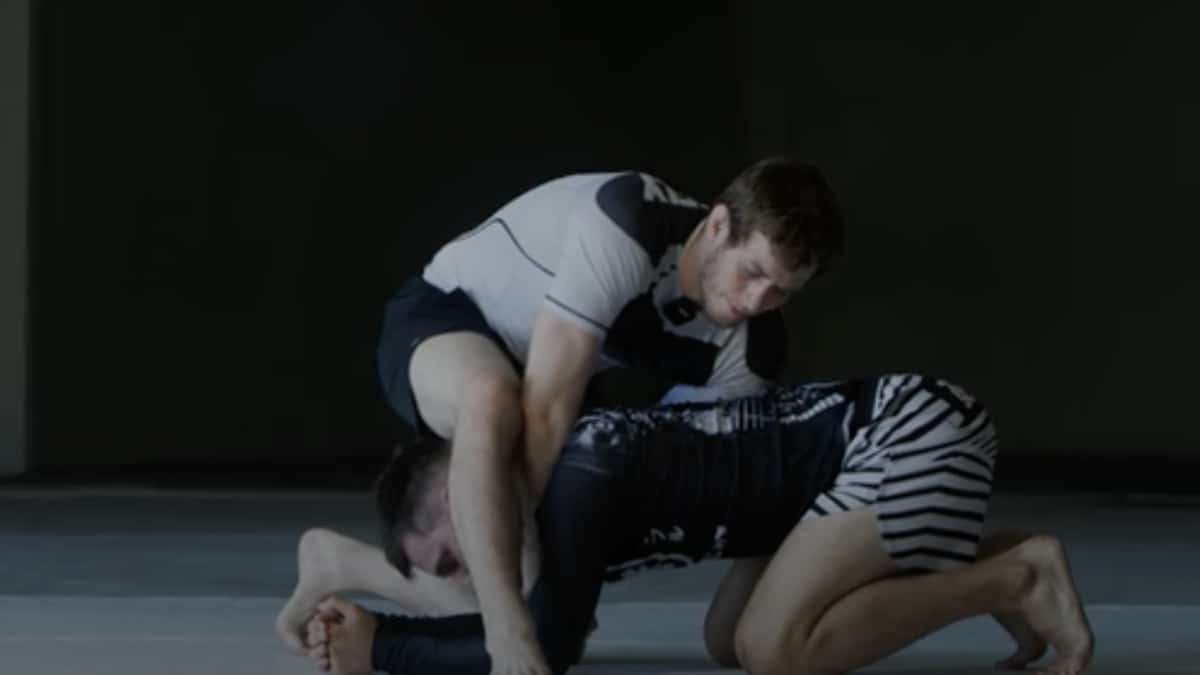Peruvian Necktie

There are numerous front headlock chokes and one of the most innovative is the Peruvian necktie. This choke is as nasty as it sounds.
It provides optimal control over your opponent and comes on quickly. This submission also inspired many other types of necktie chokes that are just as tight.
Here is our breakdown of the Peruvian necktie. We’ll go over how it was developed and its mechanics. We’ll also detail how to do the Peruvian along with other variations and give important details and tips to do it.
When was the Peruvian necktie developed?
The Peruvian necktie was developed by UFC vet Tony De Souza. Tony had a wrestling background and was an expert at gaining head control over his opponent.
He and André Pederneiras, former head coach of Nova União, were training together one day and came up with the technique. Instead of going for traditional guillotines or reverse triangles, De Souza would do something different.
What Tony would do is raise up, step next to his opponent’s head and sit back. Locking in a vicious choke that his opponent’s never saw coming.
The choke got the name the Tony De Souza choke or the Peruvian necktie as it is universally known. Since Tony is Peruvian and the choke grip looks like a necktie, that’s how they came up with the name.
De Souza’s choke caught on quickly and has been used frequently in BJJ and MMA. This choke inspired a new type of choke category known as neckties that are frequently being innovated.
The mechanics of the peruvian necktie
The mechanics of a peruvian necktie start with head and arm control on your opponent from top position. When you stand, crouch, and straighten your arms, this creates a vice around your opponent’s neck.
As you sit back, this closes the space between your arms and locks on this tight blood choke.
Peruvian necktie setup
The original Peruvian necktie starts from head control on your opponent with them in the turtle position. You have a head control with their arm in and your hands attached.
Where this front headlock choke differs from the others is your grip doesn’t need to be tight or specific. Just connect your hands and control your opponent’s head and arm.
Next you’re going to walk your leg up and attach it to the back of your opponent’s neck. This leg allows you to get force on your choke by extending it and driving your weight down into your wrist.
For the next step, you’re going to sit back at an angle on your hip. This gives you the space you need to hook your leg on your opponent’s back to keep them in place.
Once you have both of your legs in place, sit towards your other hip. Then drive your top leg down on your opponent’s neck to create force and finish the choke.
Gerbi choke(Peruvian necktie with Gi)
The Gerbi choke is a Peruvian necktie in the Gi. You do the same motions as the necktie, but use your own lapel to choke your opponent.
Instead of grabbing your grips, you turn to the side of your opponent when they’re in turtle. This is to give you space to pull out your lapel.
After you take your lapel, bring it between your opponent’s neck and far shoulder, passing it to your other hand. Pull the tail of your lapel tight as you push your opponent’s head down and step over for the finish.
Gerbi choke variation
The common defense against the Gerbi choke is that your opponent blocks you from passing your lapel. They bring their hand up and close the space between their far shoulder and neck.
If they do this it’s no problem, because there’s space under their armpit open. Turn to the centerline to give you space to pass your lapel under your opponent’s armpit.
You then bring your lapel up in between the other side of your opponent’s neck. From there, post your free hand on your opponent’s hip and step over their head.
Gerbi choke variation #2
The other common escape your opponent might try is to roll when you bring your leg up. If they’re able to get your top leg off of their head, you lose the choke.
So to stop this all you need to do is roll with your opponent. When they roll, go with them and you end up on top to finish your choke.
(This video includes the last 3 techniques.)
Japanese necktie
One of the first variations that the Peruvian necktie inspired was the Japanese necktie. It starts the same as you would begin a darce choke, but with a little necktie thrown in.
Start by sliding your arm under your opponent’s arm and bring it out on the other side of their neck. Once your hands comes through, you’re going to clasp your hands together and put your forearm on your opponent’s neck.
Usually from here, people will go for the darce and grab their biceps. But when you do this, your opponent can defend by straightening their neck.
So for the Japanese necktie, you’ll keep your hands clasped together and step over your opponent’s top leg. Pulling it toward you to establish control over their body and the space.
Now you’re going to close your elbows, fall to your shoulder, and hip in to finish the Japanese necktie.
Australian necktie
To go along with the Peruvian and Japanese necktie, you also have the Australian necktie. It starts from you doing a knee cut to pass your opponent’s half guard.
The first part of the set up is the same as the Japanese variation. You slide your hand under your opponent’s arm and clasp your hands together around their neck.
What your opponent might do to defend the Japanese necktie or darce is to fall to their back, taking it away. To do the Australian necktie, you follow your opponent as they turn and throw your leg behind their neck.
Keep your head based on the mat for balance and change your grip to you holding your shin. You’re then going to roll through and reattach your hands under your leg.
To finish the choke, bring your leg down and squeeze.
The Zamboni necktie
The Zamboni necktie is another Gi variation of the Peruvian necktie with just a little difference. With this necktie, you only need one hand inside your opponent’s collar.
Take an inside collar grip on your opponent and pull them down to the mat on all fours. From there, grab their belt with your other hand and come up to your feet in a crouching position.
Step your leg over your opponent’s neck, sit back, and drive your leg down onto their neck.
Key details and tips for doing the Peruvian necktie
The Peruvian necktie is a really slick and tight choke, but many make drastic errors to mess it up. Here are important details and tips for doing the Peruvian necktie.
- Head control: This submission always starts with gaining head control over your opponent. There is no submission without proper head control.
- Grips: Either clasp your hands together or grab onto your rest to lock in your Peruvian.
- Crouch over opponent: Once you lock in your grip, stand over your opponent and crouch over them,
- Step next to opponent’s head: Another important detail to remember is when you step up and crouch is to step next to your opponent’s head. Your other foot steps behind your opponent’s arm.
- Straighten arms: Once you crouch over your opponent, straighten your arms before sitting back.
- Chest on back: To go along with straightening your arms, you need to attach your chest to your opponent’s back. This will hold them in place before you fall back.
- Sit back: Be sure to sit straight back and at an angle on the grip side your grips are on. If you fall on your side, there won’t be any pressure on the choke.
- Leg on back of neck: The back of your thigh needs to connect to the back of your opponent’s head when you sit back. This keeps them from posturing up by trapping their head in place.
- Hook opponent’s leg or back: As you fall back, hook your outside leg on your opponent’s back or leg to keep them in place.






